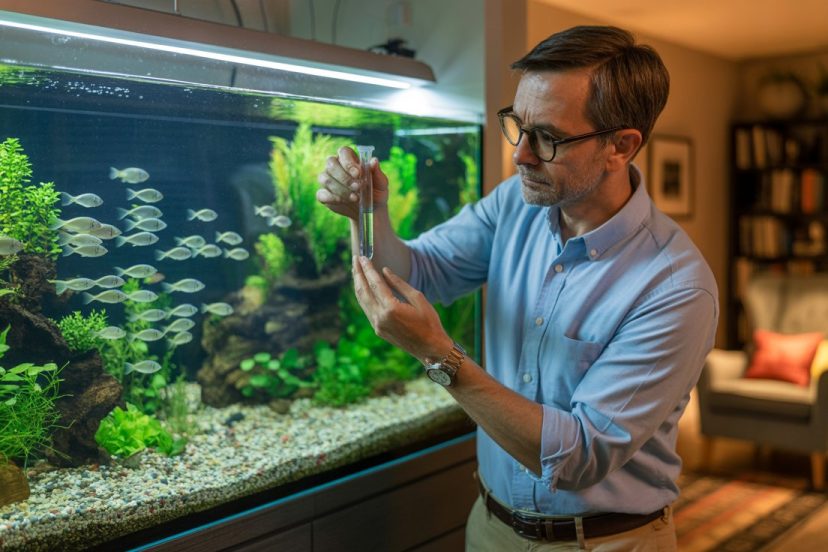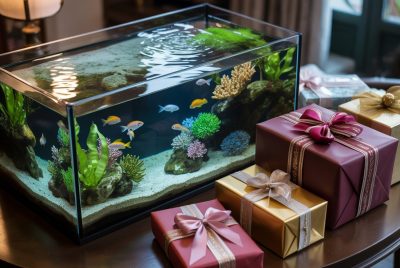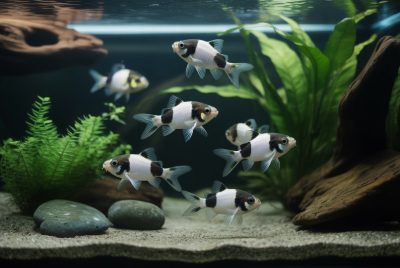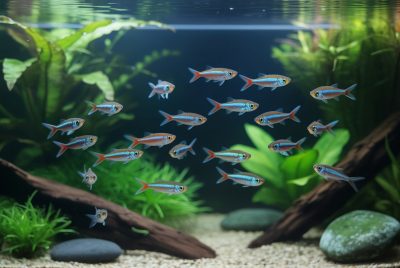How Often to Change Aquarium Water (2025 Guide)
*We may earn a commission for purchases made using our links. Please see our disclosure to learn more.
The gentle hum of an aquarium filter fills the room, but beneath that peaceful surface lies a delicate ecosystem that depends entirely on one crucial factor: water quality. Every aquarium owner has faced that moment of uncertainty, staring at their tank and wondering, “Am I changing the water enough?” or “Could I be doing this too often?”
Understanding the proper frequency for aquarium water changes isn’t just about following a schedule—it’s about creating a thriving environment where fish can flourish, plants can grow, and the entire aquatic ecosystem maintains its natural balance. The difference between a struggling tank and a vibrant underwater paradise often comes down to mastering this fundamental aspect of aquarium maintenance.
“Proper water management is the cornerstone of successful aquarium keeping. Without it, even the most expensive equipment and beautiful decorations become meaningless.”
– Marine Biology Research Journal
Key Takeaways
- Standard frequency: Change 10-25% of aquarium water weekly for most freshwater tanks
- Tank size matters: Smaller tanks require more frequent water changes than larger ones
- Fish load impact: Heavily stocked tanks need more frequent maintenance than lightly stocked ones
- Water testing is essential: Use test kits to determine actual water change needs rather than following rigid schedules
- Consistency is key: Regular, smaller water changes are better than infrequent large ones
- Emergency situations: Immediate water changes may be necessary during disease outbreaks or equipment failures
Recommended Products for Aquarium Water Maintenance
1. Aqueon Aquarium Water Changer
When learning how often to change aquarium water, having the right tool can make the process much easier. The Aqueon Aquarium Fish Tank Water Changer with 25-Foot Hose is designed to simplify routine maintenance by attaching directly to your faucet. It not only removes dirty water but also vacuums debris from gravel and quickly refills your tank with fresh, clean water.
2. API Master Test Kit
The API Freshwater Master Test Kit is a comprehensive and trusted solution for monitoring the health of your freshwater aquarium. With the ability to perform up to 800 tests, this kit includes everything you need: 7 bottles of testing solutions, 4 test tubes with caps, and a detailed color chart for accurate readings. It measures five critical water parameters—pH, high-range pH, ammonia, nitrite, and nitrate—ensuring your betta fish lives in clean, safe, and stable water conditions. Regular use of this kit helps prevent invisible water issues that can lead to stress, disease, or even loss of your fish.
A comprehensive testing kit that measures pH, ammonia, nitrite, and nitrate levels. Essential for determining when water changes are actually needed rather than guessing.
- Comprehensive Testing: Covers all essential water parameters for freshwater tanks.
- Long-Lasting Value: Provides up to 800 tests, making it cost-effective over time.
- Accurate Results: Trusted by hobbyists and professionals for precise water readings.
- Manual Process: Requires measuring and comparing to color charts, which can be time-consuming.
- Storage Space: Comes in a relatively bulky box that may take up tank cabinet space.
- No Digital Display: Lacks digital convenience some modern testers offer.
3. Seachem Prime Water Conditioner
Seachem Prime is a powerful, concentrated water conditioner that ensures your betta fish thrives in a clean and safe environment. This 500 mL bottle treats up to 5,000 gallons of water, making it both effective and economical. It instantly removes chlorine and chloramine, and detoxifies ammonia, nitrite, and heavy metals, allowing your aquarium's biofilter to work more efficiently. Whether you're performing a water change or setting up a new tank, Prime provides immediate protection, creating a stress-free habitat for your betta.
A concentrated water conditioner that removes chlorine, chloramines, and detoxifies ammonia and nitrites. One of the most trusted products for making tap water safe for fish.
- Highly Concentrated: A little goes a long way—500 mL treats up to 5,000 gallons.
- Broad Protection: Neutralizes chlorine, chloramine, ammonia, nitrite, and heavy metals.
- Emergency Use: Can be safely dosed up to 5x in urgent situations.
- Strong Odor: Has a noticeable sulfur smell some users find unpleasant.
- Precise Dosing Needed: Overdosing can cause confusion without proper measuring.
- No Built-in Dropper: Requires separate tool or care for small tank dosing.
4. Python No Spill Clean and Fill Aquarium Maintenance System
Make aquarium care stress-free with the Python No Spill Clean and Fill Aquarium Maintenance System. Designed for both beginner and seasoned aquarists, this 25-foot system completely transforms the way you clean and refill your tank—no more buckets, siphons, or messy spills. With a simple faucet attachment and gentle water flow, the Python system easily removes debris, vacuums gravel, and refills your aquarium in minutes. Compatible with most faucet types, this all-in-one kit includes everything you need to start maintaining your freshwater or saltwater tank right away. Durable, reliable, and easy to use, it’s the ultimate solution for clean, healthy aquariums with minimal effort.
The gold standard for aquarium maintenance, this system allows you to change water without lifting heavy buckets or disturbing your fish and decorations.
- Time-Saving: Cuts maintenance time from hours to minutes with fast, efficient water changes.
- Mess-Free Operation: Eliminates buckets and spills with a no-siphon, direct-to-faucet design.
- Complete Kit: Includes hose, gravel tube, faucet pump, and adapters—ready to use out of the box.
- Faucet Compatibility: May require additional adapters for non-standard faucets.
- Limited Reach: 25-foot hose may not be long enough for distant tanks.
- Price Point: Higher cost compared to traditional siphon methods.
Understanding the Science Behind Water Changes
Water changes serve multiple critical functions in aquarium maintenance. They remove accumulated waste products, replenish essential minerals, and help maintain stable water parameters that fish depend on for survival. The frequency of these changes depends on several interconnected factors that create a unique fingerprint for each aquarium.
The nitrogen cycle plays a central role in determining water change frequency. As fish produce waste and uneaten food decomposes, ammonia levels rise. Beneficial bacteria convert this ammonia to nitrites, then to nitrates. While nitrates are less toxic than ammonia or nitrites, they still need removal through regular water changes.
Tank bioload—the total amount of living organisms in the aquarium—directly impacts how quickly water quality deteriorates. A heavily stocked tank with numerous fish generates more waste than a minimally stocked one, requiring more frequent water changes to maintain healthy conditions.
Weekly Water Change Guidelines
Small Tanks (Under 20 Gallons)
Small aquariums face unique challenges due to their limited water volume. Waste products concentrate more quickly, and water parameters can shift dramatically in short periods. These tanks typically require 20-25% water changes twice weekly, or even more frequently in heavily stocked situations.
The smaller water volume means less dilution capacity for waste products. A single fish’s waste output represents a larger percentage of the total tank volume compared to the same fish in a larger system. This concentration effect makes small tanks less forgiving of maintenance lapses.
Medium Tanks (20-55 Gallons)
Medium-sized tanks offer more stability than their smaller counterparts while still requiring attentive maintenance. Weekly water changes of 15-20% typically suffice for most medium tanks with appropriate stocking levels.
These tanks provide a good balance between stability and manageability. The increased water volume offers better dilution of waste products while remaining small enough for convenient maintenance. Many aquarists find medium tanks ideal for developing consistent maintenance routines.
Large Tanks (Over 55 Gallons)
Large aquariums benefit from their substantial water volume, which provides excellent stability and dilution capacity. Weekly changes of 10-15% often maintain excellent water quality in properly stocked large tanks.
The thermal mass and chemical buffering capacity of large tanks create more stable environments. Temperature fluctuations occur more slowly, and pH swings are less dramatic. However, the sheer volume of water involved in changes requires more planning and equipment.
Factors That Increase Water Change Frequency
Overstocking
When too many fish occupy a given space, waste production exceeds the system’s processing capacity. Overstocked tanks may require daily water changes to prevent dangerous accumulation of toxic compounds.
Signs of overstocking include constant algae problems, fish gasping at the surface, frequent disease outbreaks, and rapidly deteriorating water quality despite regular maintenance. The solution involves either reducing fish numbers or significantly increasing maintenance frequency.
Heavy Feeding
Uneaten food decomposes rapidly, contributing significantly to water quality problems. Tanks with heavy feeding schedules or messy eaters require more frequent water changes to remove excess organic matter before it breaks down.
The “feed only what fish can consume in two minutes” rule helps prevent overfeeding. However, some fish species naturally produce more waste than others, regardless of feeding amounts. Large predatory fish, for example, generate substantial waste loads even with appropriate feeding.
Live Plant Considerations
Planted tanks create unique water change requirements. Healthy plants consume nitrates and produce oxygen, potentially reducing water change frequency. However, decaying plant matter and fertilizer additions may increase maintenance needs.
The plant-to-fish ratio significantly impacts water change schedules. Heavily planted tanks with few fish may require minimal water changes, while tanks with minimal plants and many fish need frequent maintenance.
Water Testing and Monitoring
Essential Parameters to Track
Regular testing provides the most accurate guide for water change frequency. Key parameters include ammonia (should always read zero), nitrites (should always read zero), nitrates (should remain below 40 ppm), and pH (should remain stable within species-appropriate ranges).
Test kits come in liquid and strip formats, with liquid tests generally providing more accurate results. Digital meters offer convenience for frequent testing but require regular calibration to maintain accuracy.
When to Test
Test water parameters at least weekly, preferably before water changes to assess current conditions. Additional testing becomes necessary during fish illness, after medication treatments, or when introducing new fish.
Emergency testing situations include fish showing stress symptoms, unusual behavior changes, or visible water quality problems. These situations may require immediate water changes regardless of the regular schedule.
Seasonal Considerations
Summer Challenges
Higher temperatures during summer months increase fish metabolism and bacterial activity, leading to faster waste accumulation. Many aquarists find they need to increase water change frequency by 20-30% during hot weather.
Increased evaporation during summer concentrates dissolved compounds, potentially creating water quality issues. Regular top-offs with treated water help maintain proper concentration levels.
Winter Adjustments
Cooler temperatures may slow biological processes, potentially allowing slight reductions in water change frequency. However, reduced daylight and indoor heating can create other challenges requiring careful monitoring.
Holiday periods often disrupt regular maintenance schedules. Planning for temporary care arrangements or automated systems becomes crucial during extended absences.
Emergency Water Change Situations
Disease Outbreaks
Fish diseases often require immediate water changes to remove pathogens and improve overall water quality. Some treatments necessitate daily water changes to prevent medication buildup.
Quarantine procedures may involve frequent water changes to maintain optimal conditions for sick fish while preventing disease spread to the main tank.
Equipment Failures
Filter failures, heater malfunctions, or power outages can quickly deteriorate water quality. Emergency water changes help maintain survivable conditions until equipment repairs are completed.
Backup equipment and emergency procedures should be planned before problems occur. Having water conditioner, backup aeration, and basic test kits readily available can save fish lives during emergencies.
Building Sustainable Maintenance Routines
Creating Consistency
Successful aquarium keeping depends more on consistency than perfection. Regular smaller water changes prove more effective than sporadic large ones, both for water quality and fish health.
Scheduling water changes on specific days helps establish routine maintenance habits. Many aquarists find weekend maintenance schedules work well with their personal schedules.
Time-Saving Techniques
Efficient water change methods reduce the time and effort involved, making regular maintenance more sustainable. Investing in proper equipment pays dividends in long-term convenience and consistency.
Preparation streamlines the process significantly. Having all equipment ready, water conditioner measured, and cleaning supplies organized reduces maintenance time and increases the likelihood of maintaining regular schedules.
Long-term Success Strategies
Successful aquarium maintenance requires balancing fish health with personal sustainability. Choosing tank sizes and stocking levels appropriate for your maintenance capacity ensures long-term success.
Documentation helps identify patterns and optimize maintenance routines. Keeping simple records of water change dates, test results, and fish behavior helps refine maintenance approaches over time.
Common Mistakes to Avoid
Temperature Shock
Adding water significantly different in temperature from tank water can stress or kill fish. Always match new water temperature to tank temperature before adding it to the aquarium.
Using a reliable thermometer for both tank and replacement water prevents temperature-related problems. Room temperature water often differs significantly from aquarium temperature.
Chlorine Exposure
Untreated tap water contains chlorine or chloramines that are lethal to fish. Always treat replacement water with appropriate water conditioners before adding it to the tank.
Different municipal water supplies use different chemicals for treatment. Understanding your local water treatment methods helps choose appropriate conditioning products.
Overcleaning
Cleaning too aggressively during water changes can disrupt beneficial bacteria colonies and destabilize the tank’s biological balance. Focus on removing waste without disturbing established bacterial colonies.
Substrate cleaning should target visible waste accumulation rather than attempting to clean every particle. Beneficial bacteria in the substrate contribute significantly to tank health.
Conclusion
Mastering aquarium water change frequency transforms aquarium keeping from a stressful guessing game into a predictable, successful routine. The key lies in understanding that every tank is unique, with its own specific needs based on size, stocking, filtration, and biological load.
Rather than rigidly following generic schedules, successful aquarists learn to read their tanks’ specific signals through regular testing and observation. They understand that consistent, appropriately sized water changes form the foundation of aquarium health, preventing problems rather than simply reacting to them.
The journey toward optimal water change routines takes time and experience. Each tank teaches valuable lessons about the delicate balance required for aquatic success. With patience, consistency, and attention to detail, any aquarist can develop the skills necessary to maintain pristine water conditions and create thriving underwater ecosystems.
Remember that water changes represent just one aspect of comprehensive aquarium care. Combined with proper filtration, appropriate feeding, and regular monitoring, they form part of a holistic approach to successful fishkeeping that rewards both fish and their keepers with years of aquatic enjoyment.
Frequently Asked Questions
How do I know if I’m changing water too often?
Signs of excessive water changes include unstable pH fluctuations, stressed fish behavior, and disrupted beneficial bacteria colonies. If your tank’s biological balance seems constantly disrupted despite regular maintenance, consider reducing change frequency or size while maintaining consistent monitoring.
Can I skip water changes if my test results look good?
Even with excellent test results, regular water changes remain important for removing dissolved organics that test kits don’t measure and replenishing trace elements. However, good test results may indicate you can slightly reduce frequency while maintaining the same change volume.
What’s the minimum water change frequency for a healthy tank?
Most established freshwater tanks require at least 10% weekly water changes as an absolute minimum. However, this varies significantly based on bioload, filtration efficiency, and tank size. Heavily stocked or small tanks may require daily changes, while lightly stocked large tanks might manage with bi-weekly changes.
Should I change water more often during the cycling process?
New tanks undergoing initial cycling benefit from frequent small water changes (10-15% every 2-3 days) to prevent toxic ammonia and nitrite buildup while beneficial bacteria establish. Once cycling completes, transition to your regular maintenance schedule.
How do I handle water changes during vacations?
For trips under a week, slightly increase the water change before leaving and reduce feeding. For longer absences, arrange for experienced help or consider automated water change systems. Never skip water changes for more than two weeks without proper tank preparation and care arrangements.













